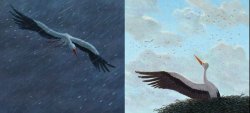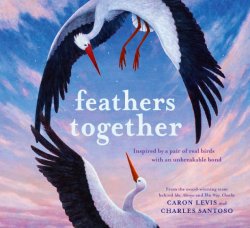
From Feathers Together, artwork by Charles Santoso © 2022 Abrams Books for Young Readers


Reviewed By Maughn Rollins Gregory
Animal stories have been used in every human time and place that we know of, not just to entertain, but to teach about the world and the place of humans in it. Many of the animal characters in myths, legends, fairy tales, folk tales, and fables are anthropomorphic. Some are fantastical. One persistent variety of these stories is the animal fable, in which we can recognize ourselves and people we know in the merits and foibles—and the consequent rewards and sufferings—of the animal characters. Most ancient animal fables were written for adults, but since the European Renaissance they have been largely coopted for the moral education of children. Indeed, many of the themes and plot lines that connect animal stories across cultures, reappear in modern children’s literature, in which animals appear as guides, moral examples, villains, and heroes.
The creator of Thinking in Stories, Gareth B. Matthews, didn’t have much use for children’s stories that moralize. Instead, he was interested in what he called philosophical fables, stories that raise various problems with the kinds of time-honored morals children are often given, by parents, teachers, and edifying stories. Matthews looked for stories that show how moral advice can be ambiguous, or how one can go wrong in following the advice, or how the advice only applies to certain kinds of situations, or how the advice runs contrary to some other, equally important advice—all of which takes some philosophical effort to figure out. The point of a philosophical fable isn’t to drive home a simple moral lesson, but to show that, pretty often, what seemed to be simple is anything but.
The fascinating and poignant picture book Feathers Together, written by Caron Levis, with gorgeous artwork by Charles Santoso, is a new kind of animal story that provokes philosophical thought in a different way. It tells the story of a mated couple of white storks named Malena and Klepetan who live and migrate together between Croatia and South Africa, until Malena is wounded in a mysterious accident. She survives but can no longer fly. An elderly, “feather headed man” adopts the couple and builds a nest on his roof for them, with a walkway for Malena to reach it. When fall comes, the man builds an indoor nest for Malena, and Klepetan migrates without her. There is some uncertainty about whether the couple will be reunited, but the following spring Klepetan returns to find Malena and rejoin her in their nest on the old man’s roof.

From Feathers Together, artwork by Charles Santoso © 2022 Abrams Books for Young Readers
On one level, the story of Malena and Klepetan works as a standard animal fable. The storks are anthropomorphized in text and images as a romantic couple facing hardship, who remain committed to one another, sustain trust and love, and work out a long-distance relationship. Their story conveys truths about the human condition—that the future is uncertain, that life comes with unexpected sorrows, including disability and separation from loved ones. It recommends the virtues of commitment and loyalty, and teaches that disability does not entail a loss of worth or dignity. In addition, the human character personifies the moral ideals of caring for others, including non-human life.
It isn’t until—indeed, if—we read Levis’s afterword that we learn that this is a true story (corroborated by numerous news articles and videos available online). Storks mate for life, and Malena and Klepetan were mated ten years before Malena’s injury, living in a nest they had made on the house chimney of a school custodian in the village of Brodski Varoš in eastern Croatia. Malena was injured by being shot by a poacher. The man who rescued her, Stjepan Vokić, was assisted by others in the village. The distance between eastern Croatia and South Africa is more than 8,000 miles, and Klepetan made that journey and returned to Malena for 19 years in a row. Over those years they had 64 children. Klepetan’s annual return was televised and celebrated in the village. Both of the storks died of old age, by which time the couple had lived together for 29 years.
Malena and Klepetan don’t need to be humanized to be personified: to be understood as beings capable of suffering and wellbeing. But what kind of emotional lives do we think storks and other animals experience, and how do we know? How is long-term pair bonding in humans and other species similar and different? What kind of wrongdoing is poaching? When should we try to rescue non-human beings in peril? Stjepan Vokić did not consider Malena and Klepetan as pets but as members of his family—can there be cross-species families? And taking a step back from the captivating true story, we might wonder if it is fair to use real or fictitious animals as examples of human virtues and vices. If the virtuous animals we encounter in stories—the industrious ant, the lazy grasshopper, the resentful fox, the love-loyal storks—don’t act with the same kind of agency as humans do, with similar temptations and existential dilemmas, what can we learn from them?
In fact and in fable, Malena, Klepetan, and Stjepan have provided us striking moral examples and important philosophical work to do.
References
Croatiaweek (2021) Famous Croatian love story ends as Malena passes away. Croatiaweek 7
July 2021. Retrieved 3 August 2023 from https://www.croatiaweek.com/famous-
croatian-love-story-ends-as-malena-passes-away/.
Bisi, Mark (2018) Man Does Everything for His Rescued Stork: Klepetan & Malena [Video]. The
Dodo on YouTube, 15 October 2018. Retrieved 3 August 2023 from
https://www.youtube.com/watch?v=sXMfbY8CawY
Gregory, Maughn Rollins and Megan Jane Laverty (2022) Frog and Toad at the Academy: Gareth
B. Matthews on How Children’s Literature Goes Philosophical. Policy Futures in
Education 20(3): 297-315.